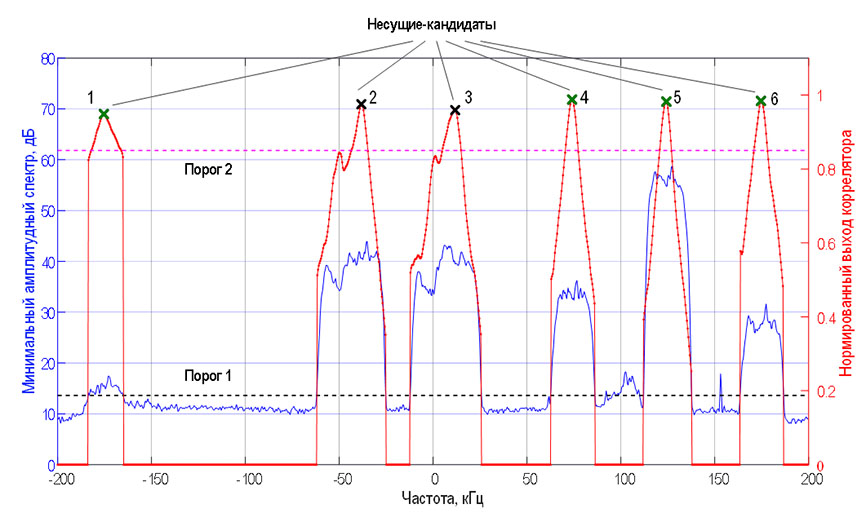
Address Direction Finding of Trunk Communication Systems Signal Sources
https://doi.org/10.31854/1813-324X-2025-11-4-67-77
EDN: KIVXAN
Abstract
Relevance. Trunk radio communication systems have become widespread in Russia and other countries. In this regard, radio intelligence and radio monitoring services must regularly search for and identify functioning radio stations, as well as their direction finding and location assessment. Trunk systems have many frequency channels, and they are dynamically allocated to subscribers for the duration of communication sessions. Since subscribers can use different radio channels at different time intervals, to determine the location of the signal source it is necessary to select its bearings in all radio channels of the system. To solve this problem, address direction finding must be used, which includes detection of signals from trunk network sources, their identification and formation of bearings of identified sources.
The aim of the work is to develop algorithms for address direction finding of signal sources of trunk networks DMR, dPMR, NXDN, APCO P25, TETRA. The paper uses methods of computer and full-scale modeling of the developed algorithms. The instrumental base used is a two-channel receiver, an antenna array, trunk systems analyzers and test radio stations.
Novelty. The paper presents an algorithm for address direction finding of signal sources of trunk communication systems DMR, dPMR, P25, NXDN, TETRA, which performs detection, identification of signal sources and formation of an estimate of the direction to these sources. An algorithm for the preliminary detection of active radio channels of trunk networks has been developed, which allows for a significant reduction in the number of analyzed carrier frequencies and an increase the speed of the analyzer.
Decision. The implementation of the presented algorithm of address direction finding is based on the use of trunk system analyzers and a two-channel radio receiver with an antenna array and navigation equipment. The analyzers implement “addressability”, and the two-channel receiver and antenna array implement direction finding of identified sources. Based on spectral analysis, an algorithm for the preliminary detection of active radio channels of trunk networks has been developed.
Practical significance. The implementation of address direction finding of signal sources of trunk communication systems allows determining their location and expands the functionality of existing signal analyzers. The use of the developed algorithm for preliminary detection of active radio channels significantly reduces the analysis time. The developed algorithms for address direction finding have been implemented and successfully tested in the analyzer of signal sources of trunk communication systems based on the direction finder ARTIKUL-M1.
About the Authors
V. B. ManelisRussian Federation
V. A. Sladkikh
Russian Federation
V. A. Kozmin
Russian Federation
D. V. Shatilov
Russian Federation
References
1. Rembovsky А.M., Ashikhmin А.V., Kozmin V.А. Radio Monitoring – Tasks, Methods, Means. Moscow: Goryachaya liniya – Telekom Publ.; 2015. 640 p. (in Russ.)
2. Rembovsky А.M., Ashikhmin А.V., Kozmin V.А. Automated Radio Monitoring Systems and Their Components. Moscow: Goryachaya liniya – Telekom Publ.; 2022. 488 p (in Russ.)
3. Bespalov О.V., Bocharov D.N., Kayukov I.V., Kozmin V.А., Manelis V.B. DMR Radio Station Signals Analyzer. Spectekhnika i svyaz'. 2016;4:106–110 (in Russ.)
4. Ashikhmin А.V., Bocharov D.N., Kozmin V.А., Kryzhko I.B., Sladkikh V.A. APCO P25 Radio Station Signals Analyzer. Spectekhnika i svyaz'. 2016;4:111–114 (in Russ.)
5. Zhukov A.A., Zaitsev A.A., Kozmin V.А., Sysoev D.S. TETRA and DECT Base Station Analyzers. Spectekhnika i svyaz'. 2012;3:35–40 (in Russ.)
6. Kozmin V.А., Kryzhko I.B., Tokarev A.B., Fateev A.A. Determining the Location of Radio Emission Sources. Spectekhnika i svyaz'. 2016;4:60–68 (in Russ.)
7. Manelis V.B., Sladkikh V.A., Kozmin V.A., Bizyukov P.E. Base station address direction finding of GSM, UMTS, LTE cellular networks. Systems of Control, Communication and Security. 2021;2:142–158 (in Russ.). DOI:10.24412/2410-9916-2021-2-142-158. EDN:ONSJJS
8. Manelis V.B., Kozmin V.A., Sladkikh V.A. Detection and identification of base stations of 5G cellular networks. Systems of Control, Communication and Security. 2021;3:152–178 (in Russ.) DOI:10.24412/2410-9916-2021-3-152-178. EDN:VKAIOR
9. ETSI TS 102 361-1 V2.3.1 (2013-07). Electromagnetic compatibility and Radio spectrum Matters (ERM). Digital Mobile Radio (DMR) Systems. Part 1: DMR Air Interface (AI) protocol. 2013. 174 p.
10. TIA-102.BAAA-A. Project 25. FDMA – Common Air Interface. New Technology Standards Project – Digital Radio Technical Standards. 2003.
11. ETSI TS 102 490 V1.8.1 (2014-06). Electromagnetic compatibility and Radio spectrum Matters (ERM). Peer-to-Peer Digital Private Mobile Radio using FDMA with a channel spacing of 6,25 kHz with e.r.p. of up to 500 mW. 2014. 67 p.
12. NXDN TS 1-A Version 1.3. Part 1: Air interface. Sub-part A: Common Air Interface. 2011.
13. ETSI TS 100 392-2 V2.4.1 (2003-10). Terrestrial Trunked Radio (TETRA). Voice plus Data (V+D). Part 2: Air Interface (AI). 2003. 813 p.
Review
For citations:
Manelis V.B., Sladkikh V.A., Kozmin V.A., Shatilov D.V. Address Direction Finding of Trunk Communication Systems Signal Sources. Proceedings of Telecommunication Universities. 2025;11(4):67-77. (In Russ.) https://doi.org/10.31854/1813-324X-2025-11-4-67-77. EDN: KIVXAN


































